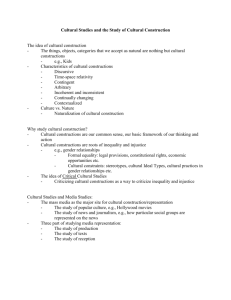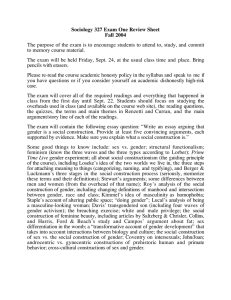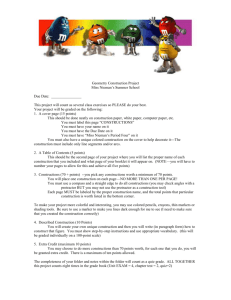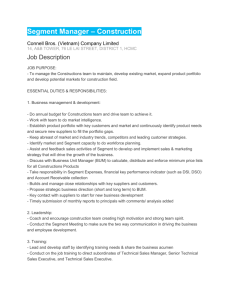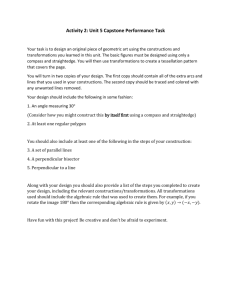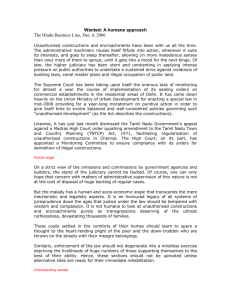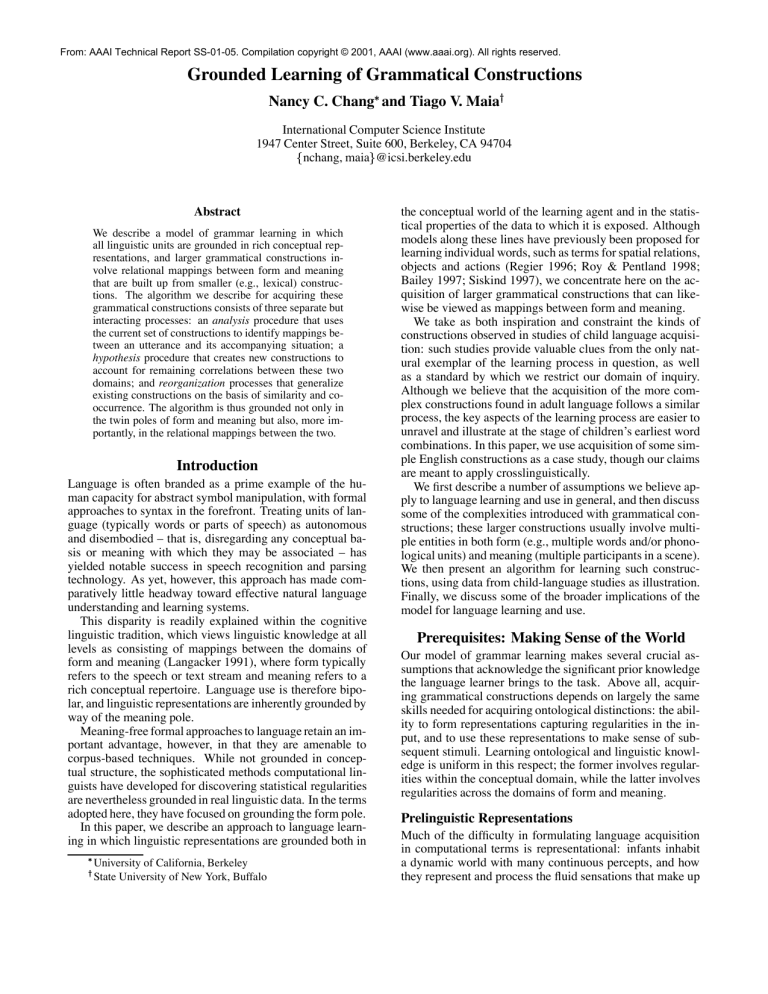
From: AAAI Technical Report SS-01-05. Compilation copyright © 2001, AAAI (www.aaai.org). All rights reserved.
Grounded Learning of Grammatical Constructions
Nancy C. Chang and Tiago V. Maiay
International Computer Science Institute
1947 Center Street, Suite 600, Berkeley, CA 94704
fnchang, maiag@icsi.berkeley.edu
Abstract
We describe a model of grammar learning in which
all linguistic units are grounded in rich conceptual representations, and larger grammatical constructions involve relational mappings between form and meaning
that are built up from smaller (e.g., lexical) constructions. The algorithm we describe for acquiring these
grammatical constructions consists of three separate but
interacting processes: an analysis procedure that uses
the current set of constructions to identify mappings between an utterance and its accompanying situation; a
hypothesis procedure that creates new constructions to
account for remaining correlations between these two
domains; and reorganization processes that generalize
existing constructions on the basis of similarity and cooccurrence. The algorithm is thus grounded not only in
the twin poles of form and meaning but also, more importantly, in the relational mappings between the two.
Introduction
Language is often branded as a prime example of the human capacity for abstract symbol manipulation, with formal
approaches to syntax in the forefront. Treating units of language (typically words or parts of speech) as autonomous
and disembodied – that is, disregarding any conceptual basis or meaning with which they may be associated – has
yielded notable success in speech recognition and parsing
technology. As yet, however, this approach has made comparatively little headway toward effective natural language
understanding and learning systems.
This disparity is readily explained within the cognitive
linguistic tradition, which views linguistic knowledge at all
levels as consisting of mappings between the domains of
form and meaning (Langacker 1991), where form typically
refers to the speech or text stream and meaning refers to a
rich conceptual repertoire. Language use is therefore bipolar, and linguistic representations are inherently grounded by
way of the meaning pole.
Meaning-free formal approaches to language retain an important advantage, however, in that they are amenable to
corpus-based techniques. While not grounded in conceptual structure, the sophisticated methods computational linguists have developed for discovering statistical regularities
are nevertheless grounded in real linguistic data. In the terms
adopted here, they have focused on grounding the form pole.
In this paper, we describe an approach to language learning in which linguistic representations are grounded both in
University of California, Berkeley
y State University of New York, Buffalo
the conceptual world of the learning agent and in the statistical properties of the data to which it is exposed. Although
models along these lines have previously been proposed for
learning individual words, such as terms for spatial relations,
objects and actions (Regier 1996; Roy & Pentland 1998;
Bailey 1997; Siskind 1997), we concentrate here on the acquisition of larger grammatical constructions that can likewise be viewed as mappings between form and meaning.
We take as both inspiration and constraint the kinds of
constructions observed in studies of child language acquisition: such studies provide valuable clues from the only natural exemplar of the learning process in question, as well
as a standard by which we restrict our domain of inquiry.
Although we believe that the acquisition of the more complex constructions found in adult language follows a similar
process, the key aspects of the learning process are easier to
unravel and illustrate at the stage of children’s earliest word
combinations. In this paper, we use acquisition of some simple English constructions as a case study, though our claims
are meant to apply crosslinguistically.
We first describe a number of assumptions we believe apply to language learning and use in general, and then discuss
some of the complexities introduced with grammatical constructions; these larger constructions usually involve multiple entities in both form (e.g., multiple words and/or phonological units) and meaning (multiple participants in a scene).
We then present an algorithm for learning such constructions, using data from child-language studies as illustration.
Finally, we discuss some of the broader implications of the
model for language learning and use.
Prerequisites: Making Sense of the World
Our model of grammar learning makes several crucial assumptions that acknowledge the significant prior knowledge
the language learner brings to the task. Above all, acquiring grammatical constructions depends on largely the same
skills needed for acquiring ontological distinctions: the ability to form representations capturing regularities in the input, and to use these representations to make sense of subsequent stimuli. Learning ontological and linguistic knowledge is uniform in this respect; the former involves regularities within the conceptual domain, while the latter involves
regularities across the domains of form and meaning.
Prelinguistic Representations
Much of the difficulty in formulating language acquisition
in computational terms is representational: infants inhabit
a dynamic world with many continuous percepts, and how
they represent and process the fluid sensations that make up
their experiences remains poorly understood. Well before
the first recognizable words appear, however, a substantial
repertoire of concepts corresponding to people, objects, settings and actions will have emerged from the chaos as the
beginnings of a stable ontology.
The acquisition of these concepts from natural or naturalistic input has been addressed by models in probabilistic,
connectionist, clustering and logical frameworks. 1 For our
current spotlight on the acquisition of grammatical structures, we require only that conceptual representations exhibit the kinds of category and similarity effects known to
be pervasive in human cognition (Lakoff 1987). That is,
concepts should cluster into categories with radial structure,
preferably with graded category membership. Representations should also facilitate the identification of similar concepts and provide some basis for generalization.
An important additional requirement comes from the assumption that many early concepts involve multiple entities interacting within the context of some unified event
(Tomasello 1992). Prelinguistic children are competent
event participants who have accumulated structured knowledge about the roles involved in different events and the
kinds of entities likely to fill them. Again, although the formation of such concepts is not our current focus, we assume
that biologically grounded processes such as those described
in the companion paper give rise to frame-based representations that capture the crucial relational structure of many
sensorimotor actions and events. Similar processes should
apply to conceptual knowledge of all kinds: while sensorimotor concepts presumably dominate the earliest stages
of concept formation, aspects of the surrounding social and
cultural context are also firmly in place prelinguistically;
frame-based social knowledge seems to underlie children’s
early grasp of basic interaction (e.g., turn-taking), as well as
more cultural frames associated with, for example, meals,
play and clothing.
Frames may be expressed using simple role-filler notation, e.g., throw [Thrower = Human. Throwee = Object.],
for an action-specific throw frame with a Human thrower
acting on an Object throwee. It will also be convenient
to represent frames in terms of individual role bindings:
Throw.thrower:Human and Throw.throwee:Object . Note that
although these representations highlight relational structure
and obscure lower-level features of the underlying concepts,
both aspects of prelinguistic knowledge will be crucial to
our approach to language learning.
Linguistic units are based on the same kinds of correlations
as those described above, where one domain happens to be
the acoustic signal in the learner’s environment. The other
domain ranges over the entire conceptual ontology, from
simple representations of people and objects to much more
complex actions and interactions whose physical referents
may be more transient and difficult to identify.
Not surprisingly, early words behave much like other categories, in both form and meaning poles. 2 Lexical items are
initially tightly coupled with the specific events, contexts
and even purposes with which they have co-occurred. They
are also subject to polysemy effects, since the same form
may be encountered in multiple distinct (though possibly related) contexts, which may be diverse enough to resist a single generalization. The word up, for example, may initially
have several distinct uses: as a request to be picked up; as
a comment on an upward movement; as a remark about a
highly placed item; etc. (Bloom 1973).
As this example makes clear, children in the one-word
stage have already acquired a number of primitive speech
acts – remarkably enough, single words (often in conjunction with intonational cues) seem sufficient for expressing
toddlers’ requests, comments, refusals and even queries. It
is important, however, to distinguish such pragmatic sophistication from the form-meaning associations we address in
this paper; despite their initial context-bound nature, most
word meanings eventually become generalized toward representations that are neutral with respect to speech act.
Though less is known about children’s early language
comprehension abilities, general pragmatic skills play a similarly dominant role early on, with simple lexical associations supplementing the complex reasoning children have
developed to behave successfully in social situations. As
the language learner amasses an increasing collection of relatively stable form-meaning pairs, however, the linguistic
cues become better correlated with the environment and accordingly more informative.
To a large extent, we can characterize adult language in a
similar vein: mature users of language also rely on relatively
impoverished form cues that, in combination with extensive
pragmatic reasoning, evoke vastly more complex conceptual
structures. The larger theoretical framework in which the
current work is situated takes a simulation-based approach
to language understanding (Narayanan 1997; Bergen, Chang
& Paskin, to appear). Under such an approach, linguistic
constructions serve as a bridge between utterances and active, embodied representations (see also submission by Feldman to this symposium). In other words, understanding an
utterance involves using constructional mappings between
form and meaning to specify parameters for a simulation,
and the inverse mapping holds for language production.
These claims are relatively uninformative in the case of
single-word constructions, but place strong requirements on
how larger constructions are represented. We now discuss
some of these representational complexities, before addressing how such constructions are learned.
1
Typically, input data corresponding to sensorimotor input is
described using a set of continuous and/or discrete features, and
standard machine learning techniques are used to acquire categories based on supervised or unsupervised training. See (Bailey
1997; Roy & Pentland 1998), as well as references in the companion paper (Maia & Chang 2001).
2
Some researchers have modeled the acquisition of word form
categories, using data from the acoustic domain (Brent 1999). This
issue, and that of how children learn to correlate articulatory gestures with auditory signals, will not be discussed here; discovering
these regularities requires the same ability to detect intra- and interdomain regularities assumed in the previous section.
Linguistic Units as Cross-Domain Correlations
Grammatical Constructions
meaning
form
We base our representations of grammatical knowledge on
ideas from Construction Grammar (Goldberg 1995) and
Cognitive Grammar (Langacker 1991). In these approaches,
larger phrasal and clausal units are, like lexical constructions, pairings of form and meaning. A key observation in
the Construction Grammar tradition is that the meaning of
a sentence may not be strictly predictable from the meaning
of its parts; the syntactic pattern itself may also contribute a
particular conceptual framing. For example, the CausedMotion construction underlying Pat sneezed the napkin off
the table imposes a causative reading on the typically noncausative verb sneeze, and the need for an agentive recipient
in the Ditransitive construction renders Harry kicked the
door the ball somewhat anomalous.
On this account, syntactic patterns are inextricably linked
with meaning, and grammaticality judgments are rightly influenced by semantic and pragmatic factors. That is, the interpretation and acceptability of a particular utterance depends not only on well-formedness conditions but also on
the structure of the language user’s conceptual ontology and
on the situational and linguistic context.
The main representational complexity introduced with
these multi-word constructions is the possibility of structure in the form pole. That is, although single words can
evoke complex frames with multiple participant roles (e.g.,
bye-bye, baseball), the actual mapping between the form and
meaning pole is necessarily straightforward. With multiple
form units available, however, additional structures arise,
both within the form pole itself and, more significantly, in
the relation between the form and meaning poles.
In addition to the sound or stress patterns of individual
words, the form pole includes intonational contours, morphological inflections and word order. As with single words,
the meaning pole encompasses the much larger set of framebased conceptual knowledge. The constructional mapping
between the two domains typically consists of a set of form
relations (such as word order) corresponding to a set of
meaning relations (in the form of frame bindings). FigTHROW- TRANSITIVE
t3
t2
t1
constructional
I
MEANING
meaning
I
form
FORM
The lexical constructions for I, throw and the-ball 3
all have simple poles of both form and meaning. But besides the individual words and concepts involved in the utterance, we have a number of word order relationships (not
explicitly represented in the diagram) that can be detected in
the form domain, and bindings between the roles associated
with Throw and other semantic entities (as denoted by the
double-headed arrows within the meaning domain). Finally,
the larger clausal construction (in this case, a verb-specific
one) has constituent constructions, each of which is filled by
a different lexical construction.4
A more formal representation of the ThrowTransitive construction is given in Figure 2. Further
details about the formalism employed here can be found
in Bergen, Chang & Paskin (to appear). For our current
purposes, it is sufficient to note that this representation
captures the constituent constructions, as well as constraints
on its formal, semantic and constructional elements. Each
constituent has an alias used locally to refer to it, and
subscripts f and m are used to denote the constituent’s form
and meaning poles, respectively. A designation constraint
specifies a meaning type for the overall construction.
construction Throw-Transitive
constituents:
construct t1 of meaning type Human
construct t2 of type Throw
construct t3 of meaning type Object
formal constraints:
t1f before t2f
t2f before t3f
semantic constraints:
t1m
t2m .thrower
t2m .throwee
t3m
designates t2 m
!
!
Figure 2:
Formal representation of the Throwconstruction, with separate blocks listing
constituent constructions, formal constraints (e.g., word
order) and semantic constraints (role bindings).
Transitive
Although this brief discussion necessarily fails to do justice to Construction Grammar and related work, we hope
that it nevertheless manages to convey the essential representational demands on the structures to be learned.
Speaker
Learning Constructions
form
THE- BALL
thrower
throwee
meaning
the ball
THROW
meaning
throw
form
Throw
Ball
Given the nature of constructions – mappings linking relations in form and meaning – it is clear that the simple classification techniques used in single-word learning will not
3
Figure 1: A constructional analysis of the sentence, I throw
the ball, showing elements of form on the left, elements of
meaning on the right and constructions linking the two domains in the center. We assume a verb-specific ThrowTransitive construction, as well as some lexical constructions that serve as its constituents; see text for details.
ure 1 gives an iconic representation of some of the possible constructions involved in an analysis of I throw the ball.
The definite determiner the explicitly depends on a representation of the situational and discourse context that supports reference
resolution. For simplicity, we will ignore the internal structure of
“the ball” and treat it as an unstructured unit.
4
This example, like the rest of those in the paper, is based on utterances from the CHILDES corpus (MacWhinney 1991) of childlanguage interaction. Note that the earliest constructions children
learn seem to be verb-specific, but at later stages of development
this utterance might be seen as an instance of a more general transitive construction (Tomasello 1992).
suffice. In this section we present an algorithm for acquiring
grammatical constructions on the basis of examples, focusing on the earliest multi-word constructions. In accord with
our discussion of conceptual prerequisites, a training example is taken to consist of an utterance paired with a representation of a situation, where the former is a sequence of familiar and novel forms, and the latter a set of conceptual entities
and role bindings representing the corresponding scene.
Our approach rests on three separate but interacting procedures, shown in Figures 3, 4 and 5. In the broadest terms,
we assume that the learning agent expects correlations between what is heard and what is perceived. Some of these
correlations have already been encoded and thus accounted
for by previously learned constructions; the tendency to try
to account for the remaining ones leads to the formation of
new constructions. In other words, what is learned depends
directly on what remains to be explained.
The identification of the mappings between an utterance
and a situation that are predicted by known constructions can
be seen as a precursor to language comprehension, in which
the same mappings actively evoke meanings not present in
the situation. Both require the learner to have an analysis
procedure that determines which constructions are potentially relevant, given the utterance, and, by checking their
constraints in context, finds the best-fitting subset of those.
Once the predictable mappings have been explained away,
the learner must have a hypothesis procedure for determining which new mappings may best account for new data.
The mappings we target here are, as described in the previous section, relational. It is crucial to note that a relational
mapping must hold across arguments that are themselves
constructionally correlated. That is, mappings between arguments must be in place before higher-order mappings can
be acquired. Thus the primary candidates for relational mappings will be relations over elements whose form-meaning
mapping has already been established. This requirement
may also be viewed as narrowing the search space to those
relations that are deemed relevant to the current situation,
as indicated by their connection to already recognized forms
and their mapped meanings.
But structure hypothesis is not the only way constructions can arise. The same kinds of generalization that we
assume for conceptual and single-word learning can also apply to constructions. Generalizations driven in a bottom-up
fashion by similar or co-occurring constructions lead to the
reorganization of the set of known constructions (or constructicon). We extend previous work using Bayesian model
merging as the basis for both types of generalization (Stolcke 1994) to handle relational structures.
Details of each procedure are best illustrated by example. Consider the utterance U1 = “you throw a ball” spoken to a child throwing a ball. The situation S consists of
entities Se and relations Sr ; the latter includes role bindings between pairs of entities, as well as attributes of individual entities. In this case, Se includes the child, the
thrown ball and the throwing action, as well as potentially many other entities, such as other objects in the immediate context or the parent making the statement: S e
= fSelf,Ball,Block,Throw,Mother,. . . g. Relational bindings
include those encoded by the Throw frame, as well as
other properties and relations: Sr = fThrow.thrower:Self,
Throw.throwee:Ball, Ball.Color:Yellow, . . . g.
In the following sections we describe what the learner
might do upon encountering this example, given an
existing set of constructions C that has lexical entries for ball,throw,block,you,she, etc., as well as
a two-word throw-ball construction associating the
before(throw,ball) word-order constraint with the
binding of Ball to the throwee role of the Throw frame.
Language analysis
Given this information, the analysis algorithm in Figure 3 first extracts the set Fknown = fyou,throw,ballg,
which serves to cue constructions that have any of
these units in the form pole. In this case, Ccued =
fyou,throw,ball,throw-ballg. Next, the constraints
specified by these constructions must be matched against the
input utterance and situation. The form constraints for all
the lexical constructions are trivially satisfied, and in this
case each also happens to map to a meaning element present
in S .5 Checking the form and meaning constraints of the
throw-ball construction is only slightly less trivial: all
relations of interest are directly available in the input utterance and situation.6
Analyze utterance. Given an utterance U in situation
S and current set of constructions , produce the bestfitting analysis A:
C
1. Extract the set Fknown of familiar form units from U ,
and use them to cue the set Ccued of constructions.
2. Find the best-fitting subset CA of Ccued for utterance
U in situation S . Let FA be the set of form units
and relations in U used in CA , and MA be the set of
meaning elements and bindings in S accounted for
by CA . Then A = < CA FA MA >. A has an associated cost CostA providing a quantitative measure
of how well A accounts for U in S .
3. Reward constructions in CA ; penalize cued but unused constructions, i.e., those in Ccued CA .
n
Figure 3: Construction analysis.
In the eventual best-fitting analysis A, the constructions used are CA =fyou,throw,ball,throwballg, which cover the forms and form relations in
FA = fyou,throw,ball,before(throw,ball)g and
map the meanings and meaning relations in M A =
fSelf,Throw,Ball,Throw.throwee:Ballg. (Remaining unused
in this analysis is the form a.)
5
We assume the you construction is a context-dependent construction that in this situation maps to the child (Self).
6
Many complications arise in adult language – category constraints on roles may apply only weakly, or may be overridden by
the use of metaphor or context. At the stage of interest here, however, we assume that all constraints are simple and few enough that
exhaustive search should suffice, so we omit the details about how
cueing constructions, checking constraints and finding the bestfitting analysis proceed.
Construction hypothesis based on explaining away
Constructicon reorganization
We proceed with our example by applying the procedure
shown in Figure 4 to hypothesize a new construction.
All form relations and meaning bindings, respectively,
that are relevant to the form and meaning entities involved in the analysis are extracted as, respectively, Frel
=
fbefore(you,throw), before(throw,ball),
before(you,ball)g and Mrel = fThrow.thrower:Self,
Throw.throwee:Ballg; the remainder of these not used
in the analysis are Frem = fbefore(you,throw),
before(you,ball)g and Mrem = fThrow.thrower:Selfg.
The potential construction Cpot derived by replacing terms
with constructional references is made up of form pole
fbefore(youf ,throwf ),before(youf ,ballf )g
and
meaning pole fThrow m .thrower:youm g. The final construction CU1 is obtained by retaining only those relations
in Cpot that hold over correlated arguments:
So far we have described an analysis-hypothesis approach
to learning constructions on the basis of a single example
and a set of existing constructions. A separate process that
takes place in parallel is the data-driven, bottom-up reorganization of the constructicon on the basis of similarities
among and co-occurrences of multiple constructions. Figure 5 gives a high-level description of this process; we refrain from delving into too much detail here, since these processes are closely related to those described for other generalization problems (Stolcke 1994; Bailey 1997).
(fbefore(youf ,throwf )g, fthrowm .thrower:youm g)
Hypothesize construction. Given an analysis A of
utterance U in situation S , hypothesize a new construction CU including correlated but unused form and
meaning relations:
1. Find the set Frel of form relations in U that hold between the familiar forms Fknown , and the set Mrel
of meaning relations in S that hold between the
mapped meaning elements in MA .
2. Find the set Frem
Frel FA of relevant form relations that remain unused in A, and the set Mrem
Mrel MA of relevant meaning relations that remain
unmapped in A. Create a potential construction Cpot
= (Frem ,Mrem ), replacing terms with references to
constructions in CA where possible.
3. Create a new construction CU consisting of pairs of
form-meaning relations from Cpot whose arguments
are constructionally related.
4. Reanalyze utterance using
CU , producing a
new analysis A0 with cost CostA0 . Incorporate CU
into if CostA CostA0
MinImprovement; else
put CU in pool of potential constructions.
5. If U contains any unknown form units, add the
utterance-situation pair U S to the pool of unexplained data.
n
C
n
=
;
(
=
C f g
)
Figure 4: Construction hypothesis.
At this point, the utility of CU1 can be evaluated by reanalyzing the utterance to ensure a minimum reduction of
the cost of the analysis. As noted in Step 4 of Figure 4, a
construction not meeting this criterion is held back from immediate incorporation into C . It is possible, however, that
further examples will render it useful, so it is maintained as
a candidate construction. Similarly, Step 5 is concerned with
maintaining a pool of examples that involve unexplained
units of form, such as the unfamiliar article a in this example. Further examples involving similar units may together
lead to the correct generalization, through the reorganization
process to which we now turn.
C
Reorganize constructicon. Incorporate a new construction Cn into an existing set of constructions ,
reorganizing to consolidate similar and co-occurring
constructions if necessary:
C
1. Find potential construction pairs to consolidate.
Merge constructions involving correlated relational mappings over one or more pairs of similar
constituents, basing similarity judgments and type
generalizations on the conceptual ontology.
Compose frequently co-occurring constructions
with compatible constraints.
2. Evaluate constructions; choose the subset maximizing the posterior probability of on seen data.
C
Figure 5: Constructicon reorganization.
Continuing our example, let us assume that the utterance
U2 = “she’s throwing a frisbee” is later encountered in con-
junction with an appropriate scene, with similar results: in
this case, both the unfamiliar inflections and the article are
ignored; the meanings are mapped; and constraints with appropriate correlations are found, resulting in the hypothesis
of the construction CU2 :
(fbefore(shef ,throwf )g, fthrowm .thrower:shem g)
CU1 and CU2 bear some obvious similarities: both constructions involve the same form relations and meaning bindings,
which hold of the same constituent construction throw.
Moreover, the other constituent is filled in the two cases
by she and you. As emphasized in our discussion of conceptual representations, a key requirement is that the meaning poles of these two constructions reflect their high degree of similarity.7 The overall similarity between the two
constructions can lead to a merge of the constructional constituents, resulting in the merged construction:
(fbefore(hf ,throwf )g,fthrowm .thrower:hm g)
where h is a variable over a construction constrained to have
a Human meaning pole (where Human is a generalization
over the two merged constituents). A similar process, given
appropriate data, could produce the generalized mapping:
(fbefore(throwf ,of )g,fthrowm .throwee:om g)
7
The precise manner by which this is indicated is not at issue.
For instance, a type hierarchy could measure the distance between
the two concepts, while a feature-based representation might look
for common featural descriptions.
where o is constrained to have an Object meaning pole. 8
Besides merging based on similarity, constructions may
also be composed based on co-occurrence. For example, the
generalized Human -throw and throw-Object constructions just described are likely to occur in many analyses in
which they share the throw constituent. Since they have
compatible constraints in both form and meaning (in the latter case even based on the same conceptual Throw frame),
repeated co-occurrence eventually leads to the formation of
a larger construction that includes all three constituents:
(fbefore(hf ,throwf ),before(throwf ,of )g,
fthrowm .thrower:hm ,throwm .throwee:om g)
Both generalization operations we describe are, like the hypothesis procedure, merely means of finding potential constructions. Due to space considerations, we do not discuss
the many complexities that arise in evaluating these constructions using Bayesian criteria. Briefly, a prior based on
minimum description length favors merged and composed
constructions that compactly encode previously seen data;
this measure combats the inevitable drop in likelihood associated with these more general constructions. The learning
algorithm chooses the set of constructions that maximizes
the posterior probability of the constructicon given the data.
Discussion
The model we have proposed for the acquisition of grammatical constructions makes some strong claims about the
relationship between comprehension, production and learning. We take these three processes to be tightly linked: new
constructions are hypothesized specifically to make up for
correlations not covered by currently known constructions,
and productions are based largely on the most entrenched
subset of previously acquired constructions.
The model is compatible to the extent possible with evidence from child language acquisition. The principles guiding construction hypothesis, in particular those for mapping
relevant form and meaning relations, have counterparts in
some of Slobin’s (1985) Operating Principles for mapping.
Construction reorganization allows more general constructions to result from the merging of lexically specfic constructions like those described by (Tomasello 1992).
More broadly, since the algorithm produces constructions
based on any utterance-situation pair and existing constructicon represented as described above, it can apply equally well
for more advanced stages of language development, when
the learner has more sophisticated meaning representations
and more complex constructions. The potential continuity
between early language acquisition and lifelong constructional reorganization offers hope for the modeling of adaptive language understanding systems, human and otherwise.
Acknowledgments
We are grateful for the input and influence of Jerry Feldman
and the rest of the NTL group at ICSI; opinions and errors
8
Although not further discussed here, examples with unexplained forms (such as the a in U1 and U2 ) may also undergo merging, leading to the emergence of common meanings.
remain ours alone. This work was supported in part by an
IBM Research Fellowship granted to the first author, and a
Praxis XXI Fellowship from the Portuguese “Fundação para
a Ciência e a Tecnologia” to the second author.
References
Bailey, D. R. 1997. When Push Comes to Shove: A Computational Model of the Role of Motor Control in the
Acquisition of Action Verbs. Ph.D. Dissertation, University of California at Berkeley.
Bergen, B. K.; Chang, N. C.; and Paskin, M. A. To appear.
Simulation-based language understanding in Embodied
Construction Grammar. In Östman, J.-O., ed., Construction Grammar(s): Cognitive and Cross-language
dimensions. John Benjamins.
Bloom, L. 1973. One word at a time: the use of single word
utterances before syntax. The Hague: Mouton & Co.
Brent, M. R. 1999. An efficient, probabilistically sound algorithm for segmentation and word discovery. Machine
Learning 34(1-3).
Goldberg, A. E. 1995. Constructions: A Construction
Grammar Approach to Argument Structure. University
of Chicago Press.
Lakoff, G. 1987. Women, Fire, and Dangerous Things. University of Chicago Press.
Langacker, R. W. 1991. Concept, Image, and Symbol: The
Cognitive Basis of Grammar. Cognitive Linguistics
Research. Berlin and New York: Mouton de Gruyter.
MacWhinney, B. 1991. The CHILDES project: Tools for
analyzing talk. Hillsdale, NJ: Erlbaum.
Maia, T. V., and Chang, N. C. 2001. Grounding the acquisition of grammar in sensorimotor representations. Proc.
2001 AAAI Spring Symposium on Learning Grounded
Representations.
Narayanan, S. 1997. Knowledge-based Action Representations for Metaphor and Aspect (KARMA). Ph.D. Dissertation, University of California at Berkeley.
Regier, T. 1996. The Human Semantic Potential. MIT Press.
Roy, D., and Pentland, A. 1998. Learning audio-visually
grounded words from natural input. In Proc. AAAI
workshop on Grounding Word Meaning.
Siskind, J. M. 1997. A computational study of crosssituational techniques for learning word-to-meaning
mappings. Chapter 2. MIT Press.
Slobin, D. I. 1985. Crosslinguistic evidence for the
language-making capacity. Volume 2 of The Crosslinguistic Study of Language Acquisition. Chapter 15.
Mahwah, New Jersey: Lawrence Erlbaum Associates.
Stolcke, A. 1994. Bayesian Learning of Probabilistic Language Models. Ph.D. Dissertation, University of California, Berkeley.
Tomasello, M. 1992. First verbs: A case study of early
grammatical development. Cambridge, UK: Cambridge University Press.

